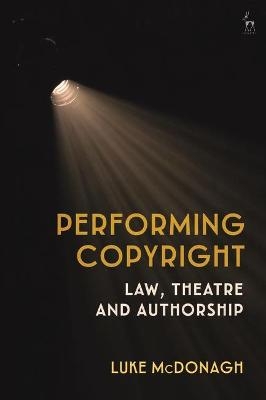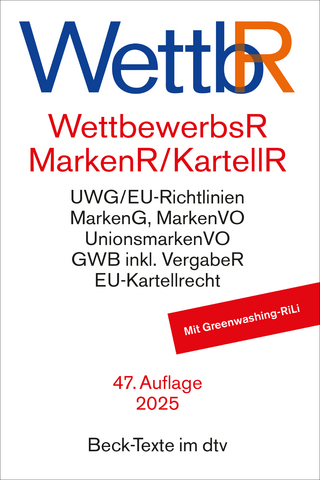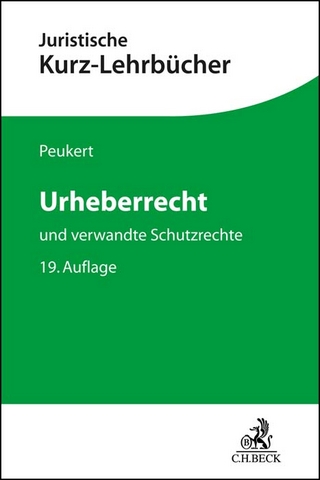
Performing Copyright
Hart Publishing (Verlag)
978-1-5099-4916-8 (ISBN)
To evaluate these questions in the context of theatre, the first part of the book examines the history of the dramatic work both as text and as performative work. The second part explores the notions of authorship and joint authorship under copyright law as they apply to the actual process of creating plays, referring to legal and theatrical literature, as well as empirical research. The third part looks at the notion of copyright infringement in the context of theatre, noting that cases of alleged theatrical infringement reach the courts comparatively rarely in comparison with music cases, and assessing the reasons for this with respect to empirical research. The fourth part examines the way moral rights of attribution and integrity work in the context of theatre. The book concludes with a prescriptive comment on how law should respond to the challenges provided by the theatrical context, and how theatre should respond to law.
Very original and innovative, this book proposes a ground-breaking empirical approach to study the implications of copyright law in society and makes a wonderful case for the need to consider the reciprocal influence between law and practice.
Luke McDonagh is Assistant Professor in the Law Department at the London School of Economics and Political Science.
1. Introduction – Copyright and Authorship on Stage
The Rationale for this Book
Overview of Jurisdictional Limitations and Thematic Scope
A Theoretical Approach to Law and Authorship
Copyright’s Cultural Turn
Empirical Methodology
Using Bourdieu to Frame the Empirical Case Study
Overview of Chapters
2. ‘The Play’s The Thing …’ But What’s the Play? And Who Owns It?
Introduction
Assessing the Relevance of Literary Theory and Theatre Studies on Legal Issues of Authorship
Tracing the Influence of Law on Theatre and Theatre on Law: The Role of the Inns of Court and the Impact of the Stationers’ Company in the Elizabethan and Jacobean Eras (1558–1625)
Law and Theatre: Assessing the Theatrical Text and Authorship During the Elizabethan and Jacobean Eras (1558–1625)
Ownership of Plays in the Elizabethan and Jacobean Eras (1558–1625)
Theatrical Collaboration as Polyvocal Authorship in the Elizabethan and Jacobean Eras (1558–1625)
An Unstable Text in the Elizabethan and Jacobean Eras (1558–1625)
A Case Study on Authorial and Textual Instability – Thomas Kyd and The Spanish Tragedy 1594–1613
The Publication of Shakespeare’s First Folio (1623) and the Beginning of his Acclamation as the English Author-Figure Par Excellence
Was Ben Jonson the First Self-conscious ‘Author’ in English Theatre?
How Reconceptualising Anonymity Influenced Authorship During the Seventeenth Century
Censorship of Theatre Texts in the Sixteenth and Seventeenth Centuries
Material Matters – Printing, ‘Piracy’ and ‘Blocking’ in the Pre-Statutory Copyright Era 1557–1709
The Changing Nature of Theatre and the Playwright’s Status, Post-Restoration (1660–1709)
The Statute of Anne 1710 and the Recognition of Authors as Owners
Changes to Theatrical Culture Post-Statute of Anne 1710
Defining the Boundaries of Copyright Protection under the Statute of Anne 1710
The Changing Appreciation of What Copyright Protected 1710–1832 – From the Print-commodity to the
Performance-commodity
The Reforms Brought About by the 1833 Act and 1842 Act – The Right to Perform a ‘Dramatic Piece’
The Problem of Dramatisations Post-1833
Authorship and Joint Authorship Under the 1833 Act and 1842 Acts
What Were the Boundaries of the ‘Dramatic Piece’ 1833–1911?
US Comparison under the 1856 US Copyright Act
International Copyright: The Berne Convention 1886
The Imperial Copyright Act 1911
Conclusion
3. Copyright Law and Performing Authorship in Theatre – Exploring the Contrasting Roles of the Playwright, Director and Performers
Introduction
Understanding the Work in Modern Copyright Law
Original Dramatic Works under the Copyright, Designs and Patents Act (CDPA) 1988
Original Musical Works
Original Literary Works
Original Works in EU Copyright Law – Assessing the ‘Dematerialised’ Work of Originality
Original Works – Comparative Insights
Summary of the UK Position on Originality of Dramatic Works
Authorship and Ownership of the Economic Rights
Overview of Joint Authorship
Joint Authorship of Dramatic Works in the UK
Joint Authorship of Musical Works in the UK
Joint Authorship – Comparative Insights
Beyond the Individual – Exploring Theatrical Authorship as a Social Practice
Evaluating the Original Dramatic Work as Theatrical Text – ‘Fully Formed’ or ‘Devised/Revised’?
Joint Authorship: How Do Dramatic Works Get Created Via the Workshop Process?
The Role of the Writer
The Role of the Director
The Role of the Actors (Performers)
The Final ‘Transcendent’ Work
Is the ‘Workshopped’ Play a Work of Joint Authorship?
The Importance of Contracts
Assessing the Legal Problems that can Arise from Sharing Ownership
Conclusion
4. When Does Copyright Infringement Occur on ‘The Haunted Stage’?
Introduction
Claims of Plagiarism and Infringement in Theatre in Historical Perspective 1709–1911
Infringement of Copyright under the 1911 Act and the 1956 Act
Infringement of Copyright under the CDPA 1988
How Much (or How Little) Needs to be Copied? The Meaning of ‘Substantial Part’
Assessing the Copying of Plots and Characters in Light of the Idea/Expression Dichotomy
New Adaptations of Public Domain Works
Comparative Insights
How Prevalent are Disputes in the UK Theatre Field?
Empirical Insights
The Defence of Fair Dealing under the CDPA
The Purposes of Criticism or Review, Quotation and Parody in the CDPA
Assessing the Fairness of the Dealing under the CDPA
Comparative Insights
Exploring the Possibility of Incorporating an Open ‘Fair Use’ Standard in the UK
Conclusion
5. Copyright’s Role in Enforcing Credit and Control in Theatre
Introduction
Moral Rights and Dramatic Works
The Attribution Right
The Integrity Right
Investigating the ‘Integrity-based Objection’ in the Context of Theatre
Godot (France)
Heretic (Australia)
Clybourne Park (Germany)
The Playboy of the Western World (Ireland)
Summary of Comparative Insights
Analysing the ‘Aura’ of the Work of Drama
Evaluating the ‘Trajectory’ of the Work of Drama
The Link between the Play’s Trajectory and the Public Domain
How Prevalent are Integrity-based Objections in Theatre Practice?
What to do about Beckett? Views from the Field
Examining the Play’s Trajectory – What Makes King Lear Different from Waiting for Godot?
Conclusion
6. How Should Law Respond to the Challenges of the Theatrical Context? How Should Theatre Respond to Law?
Introduction
The History of Authorship of Plays and the Shifting Property Boundaries of Ownership – The Text as Commodity
Copyright Law, Authorship and Joint Authorship of Plays in the Contemporary Theatre Field
Copyright Infringement – A Rare Occurrence in the Contemporary Theatre Field?
Copyright and Moral Rights in the Theatre Field – The Issue of Integrity Looms Large
Conclusion
| Erscheinungsdatum | 21.06.2021 |
|---|---|
| Verlagsort | Oxford |
| Sprache | englisch |
| Maße | 156 x 234 mm |
| Themenwelt | Recht / Steuern ► EU / Internationales Recht |
| Recht / Steuern ► Wirtschaftsrecht ► Urheberrecht | |
| ISBN-10 | 1-5099-4916-X / 150994916X |
| ISBN-13 | 978-1-5099-4916-8 / 9781509949168 |
| Zustand | Neuware |
| Haben Sie eine Frage zum Produkt? |
aus dem Bereich


